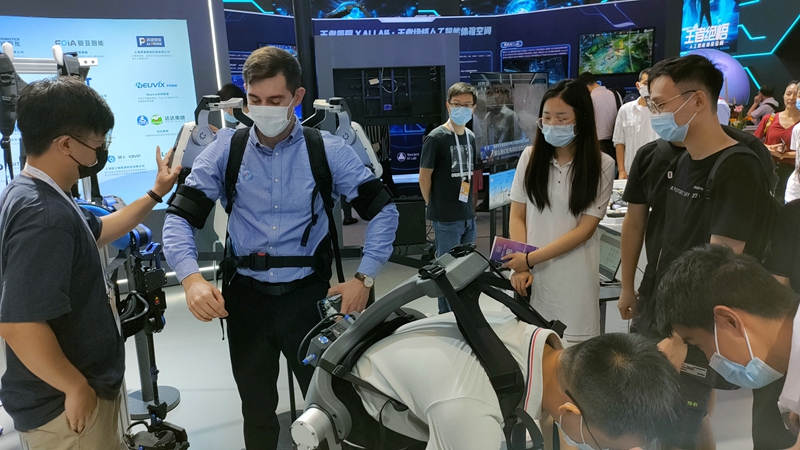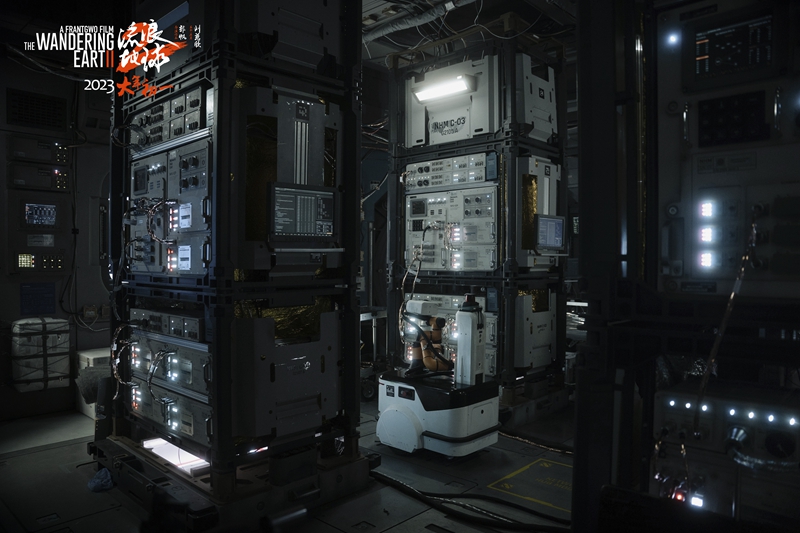In the film, automated robots from Youibot patrol within the space station, help provide data for human decision-making and carry supplies. "About 80 percent of our products fit with the designed scenes set in 2050. In the film, 16 robots of 14 different types are produced by us," Zhang Zhaohui, CEO of Youibot, told Beijing Review.
Scientists in the film wear exoskeleton robotic devices around their waists as well as on their upper and lower limbs during their missions, which were produced by ULS Robotics. The devices are used to help reduce fatigue and occupational injuries, enhance strength and increase productivity.
Both companies presented their robot products at the World Artificial Intelligence Conference in 2021, where they were discovered by the crew producing the film. The filmmakers soon decided to work in partnership with the two robot manufacturers to present a futuristic world to the audience.
Becoming smarter
Headquartered in Shenzhen, Guangdong Province, Youibot focuses on developing mobile robots for inspection and maintenance as well as smart manufacturing. Its products, which are seen moving swiftly and flexibly in the film, make use of sensors for simultaneous localization and mapping, enabling them to avoid blocks and identify the best path for motion, according to Zhang. Outside of film, the robots have been adopted for patrol duties in industries including electricity production, mining and steel. In addition, the company has also developed robots for sophisticated electronic component manufacturing, enabling smart transformation of whole semiconductor assembly lines.
Dating back to 2017, Zhang and three other partners who all graduated from Xi'an Jiaotong University founded the predecessor of Youibot in Xi'an, Shaanxi Province. According to him, they felt like hammers seeking nails in the initial phase, as they mastered the use of technologies before finding applications for them. Three years later, they narrowed down the main businesses of the company to patrol and manufacturing robots.
After addressing a fund shortage in early days, the company has developed from a team of five to one with nearly 500 employees today. In 2020, The New York Times reported Youibot antivirus robots' role in supporting the resumption of business in China during the COVID-19 pandemic. The robots could sanitize floors and scan people in public for fever. As a result, the company's products have been sold beyond China to more than 20 countries.
"Over 50 percent of our employees work on research and development (R&D). The R&D expenditure accounts for about 40 percent of our total revenue," Zhang said.
Youibot has its own factory in Shenzhen. It also outsources the production of some of its products to third-party contract manufacturers in nearby Dongguan City, which are able to produce 500 robots per month and deliver final products in 40 days.
"We have benefited from Shenzhen's preferential policies for businesses and investors. The complete supply chains and efficient logistics services here have also facilitated the purchase of parts and components, production and delivery," Zhang said.
The robotic industry is still emerging in China. In 2021, the Ministry of Industry and Information Technology (MIIT) issued a development plan for the robotic and intelligent manufacturing sectors during the 2021-25 period, focusing on boosting innovation, manufacturing and the application of innovation outcomes.
The roadmap brings great opportunities for robot companies, according to Zhang. His company will continue to explore new applications for its products in fields including semiconductor and lithium battery production, medical care and warehouse management.
China is now the world's largest market for industrial robots, with its output reaching about 366,000 units in 2021, a tenfold increase from 2015, the MIIT said.
"China is an early starter on developing mobile robots, which are being used in a wide range of applications. To increase the long-term competitiveness of made-in-China robots, the key is to improve R&D and enhance the domestic production capacity of core parts," Zhang said.

Visitors try exoskeleton robotic devices made by ULS Robotics at the World Artificial Intelligence Conference in Shanghai in July 2021 (COURTESY PHOTO)
Becoming stronger
Research of exoskeleton robotic devices in China started in 2000. In 2015, many companies emerged as the devices were put into commercial use.
Established in 2018, ULS Robotics, based in Shanghai, develops exoskeleton robotic devices for industrial and civil use, covering fields including mining, electricity production, airport ground services and elderly care. The robots are a boon for elderly people and workers in labor-intensive industries, and have also been adopted for virtual reality gaming.
"Weighing around 5 kg, our products enable wearers to lift heavy objects using less strength. At first, we focused on devices for rehabilitation, especially those facilitating the movement of senior and physically disabled people. Inspired by doctors, we expanded R&D to create lighter wearable devices to help prevent muscle injuries in workers before they have to turn to doctors," Zhang Hua, cofounder of ULS Robotics, told Beijing Review.
According to the company, its robots help cut over 60 percent of stress on wearers. People who can only lift objects weighing 20 kg by themselves are able to lift around 50 kg while wearing an exoskeleton. The most widely used are those featuring lower-back-supporting functions.
"Our products have been used in domestic airports to facilitate luggage carrying by employees, including at Beijing Daxing International Airport. As electrical cables have moved underground in China in recent years, the exoskeleton robotic devices are also helping workers carry cables more easily in the narrow spaces, reducing stress and improving efficiency," Zhang Hua said.
According to Zhang Hua, the price of an exoskeleton robotic device for industrial or civil use currently stands at around 50,000 yuan ($7,270). The annual sales of the ULS devices for industrial purposes has reached around 1,000 sets, and the company reportedly will introduce its devices for civil use to the market at the end of this year. It is also working on expanding production and making its products more affordable and easier to wear.
ULS Robotics has developed most of the technologies it uses in its products, reducing expenditure on purchasing key components. It has around 20 employees, of whom around 90 percent work on R&D. "More than 95 percent of our systems and technologies are self-developed," Zhang Hua said.
The company received the Conformité Européenne Mark last year, which certifies that a product has met the health, safety and environmental requirements of the EU. It is planning to promote its products overseas, including in European countries and the U.S., where exoskeleton robotic devices have seen wide application, according to Zhang Hua.
After three years of pandemic-induced business disruptions, Zhang Hua expects steady growth this year. "As COVID-19 impacts wane and cross-border travel has resumed, luggage carrying at airports is returning to pre-pandemic levels, which has boosted demand for our products. Many airport companies have contacted us," he said. "As our businesses resume, increasing orders for materials will boost the recovery of upstream suppliers."
The MIIT introduced a guideline in January to promote the application of robots, especially expanding the use of exoskeleton robotic devices for elderly care. As ULS Robotics projected, such devices will be widely applied in the field in the next three to five years.
In addition to commercial use, products from ULS Robotics have been adopted by universities for research and study. The company launched a lab in partnership with Beihang University, one of China's top-tier higher learning institutions for engineering, last year.
"As the robot industry covers various fields, we expect support from the government for boosting cooperation between upstream and downstream enterprises, like suppliers of batteries and materials. We also hope that more high-caliber professionals will engage in robotic research," Zhang Hua said.
(Print Edition Title: Hardcore Heavyweights)
















